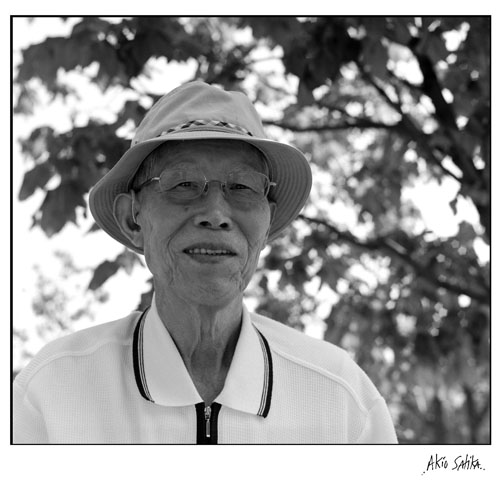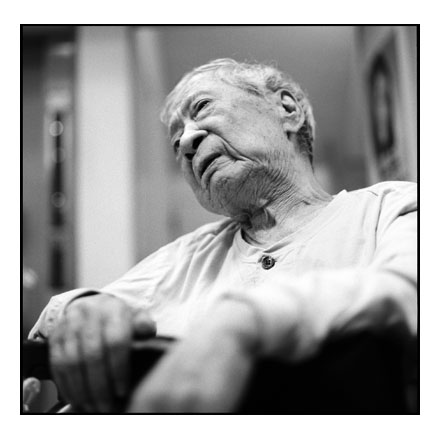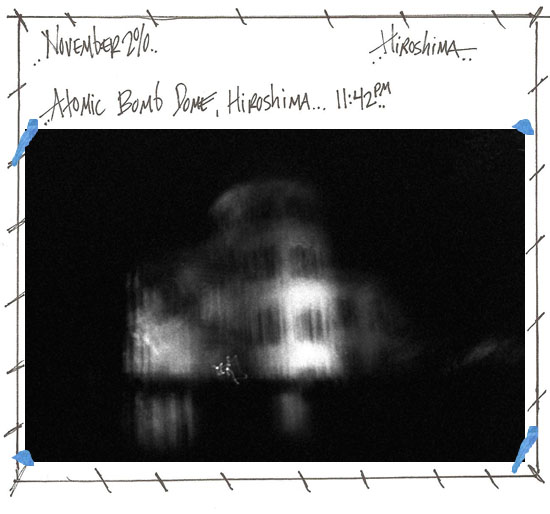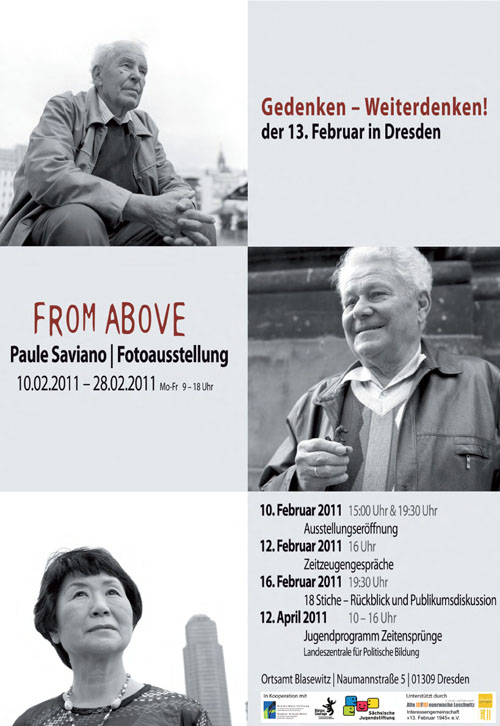..September 2008 Nagasaki..
Sumiteru Taniguchi
..Taniguchi-san was the most distinguished and sophisticated man I photographed in Nagasaki. He was impeccably dressed in a suit. His demeanor and posture very honorable. His intelligent aura immediately filled the large board room we sat in.
Taniguchi-san’s story of survival was remarkable. His dedication to the Hibakusha cause and activism against nuclear weapons is impressive. He told his story about overcoming the devastation but the bulk of our conversation was about his concerns about the bleak state of the world. The nuclear ambitions of countries like North Korea, India, Pakistan, Israel, Iran….We spoke about the recent nuclear detonations in India and Pakistan.
Taniguchi-san had the poise of a statesman. His knowledge of world affairs was extensive. In Japan, Taniguchi-san was a major figure in the Hibakusha getting rights and compensation from the government. It took many years for the government to recognize Hibakusha.
The government’s lack of recognition for many years surprised me the most. The stories of discrimination were shocking. Taniguchi-san was the most outspoken of the Hibakusha I met. He told me several times he was disappointed with the government’s unwilingness to offer more assistance to the Hibakusha.
He was also vocal about his feelings toward other Hibakusha who failed to have their voices heard. He could not understand the Hibakusha who believed the government was doing enough for the Hibakusha.
I have a great deal of respect for Taniguchi-san’s opinion and courage to be vocal. If it weren’t for his efforts the government would be waiting all the Hibakusha to pass away without memory. His desire and strength to live are what made my experience unforgettable.
..From the beginning of the photo session, I knew the image of Taniguchi-san would be the cover image for the project. He was poised and distinguished in front of the camera. You can see the his inner strength when you look at the eyes in his photos. Despite his fragile body, he was the strongest man ever to be in front of my camera.

..Taniguichi-san is known as the Postman of Nagasaki. He was delivering the mail on the morning of August 9th, 1945. He started his route at 9AM. Air raid sirens went off a couple of times but no raids occurred.
At 10AM his bicycle tire punctured. He continued the route on foot. After finishing the route, he returned to the bicycle to fix the tire.
11AM he left Nishiura-Kami post office to deliver more mail. He heard planes in the distance. Moments later he was thrown off his bicycle while the ground shook.
“….when I looked up, the house I just passed was destroyed…I saw a child blown away…When I looked up, some small children who had been playing nearby had
been blown away like dust…”
His bicycle was twisted, mail scattered on the ground. His first reaction was to pick up the letters. When he told this to me. It stuck in my memory. When I was interviewed on NHK World, told Taniguchi-san’s story, this was the first memory I had of him. I found it amazing his first reaction was to pick up the letters.
He finds shelter 200yards away in tunnel used to house munitions. He notices that the skin on his entire left arm is dripping off like a flimsy rag. The shirt on his back is literally burnt off.
In the tunnel, some people cut the hanging skin off his arm. Also cut what was left of his shirt and rubbed machine oil on his arm to stop the burning.
10 minutes after the atomic bomb….he tried to stand-up. He couldn’t move. They had to move to safer location because of the munitions….didn’t have the strength to move.
“..I tried to stand, but could not stand any more. I could not walk..”
A man than carries Taniguichi-san to a hill. People pass asking for water. They died quickly. At 2PM…People walking along the railroad tracks. Bodies piled as they fell over and died.
..Night of August 9th, 1945..
All of Nagasaki burnt during the night. Flames made the Nagasaki night as bright as sunlight. House, factories, and the mountains in smoldered feverishly. People passed searching for family.
He sees a low flying airplane. A sharp sound made by a stray bullet fired out of the plane. It hit the rock next to him. In my other interviews, there were mentions of low flying planes. But they were described as observation planes. It was common for planes to shoot survivors after air raids. This was the first I heard of a low flying plane shooting after the atomic bomb was detonated.
Around dawn it started to rain. He swallowed rain water accumulating on the tree leaves. At sunrise everyone lying around him had died. A rescue team arrived…..he tried to ask for help but they thought he was dead. Didn’t have the strength to move or talk.
He was rescued 3 days later and taken to the Shinko Elementary School.

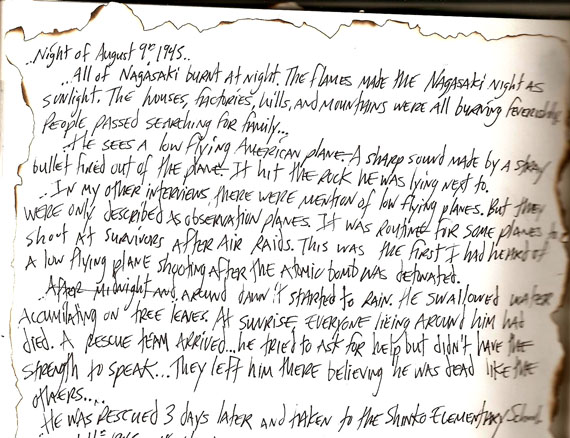
Taniguchi-san remained bed ridden, lying on his stomach for 21 consecutive months.
“….People at the hospital cheered when I was able to stand….” Taniguchi-san


“….In my thoughts, I thought about all the people who died. I was still in pain, but still alive….” Taniguchi-san
“….The war ended 64 years ago, but not for us. The victims have been suffering ever since and we don’t know it’s going to effect future generations….” Taniguchi-san

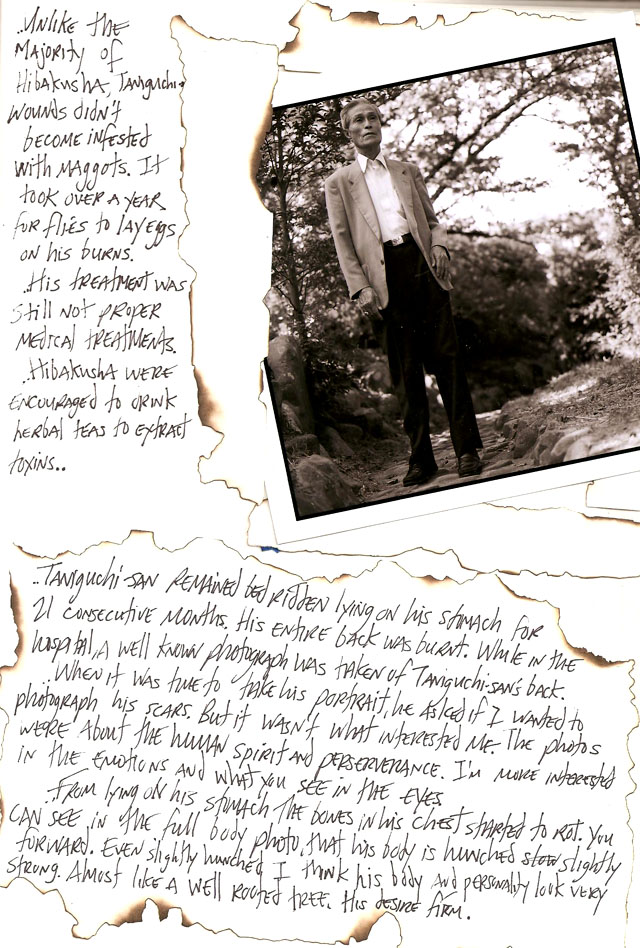

“..There was a woman who could not hear. Her face swollen, she could not open her eyes. Injured from head to toe. Groaning in pain. I still remember her, like I saw it yesterday. I could not do anything. I deeply regret that, even today..” Taniguchi-san
